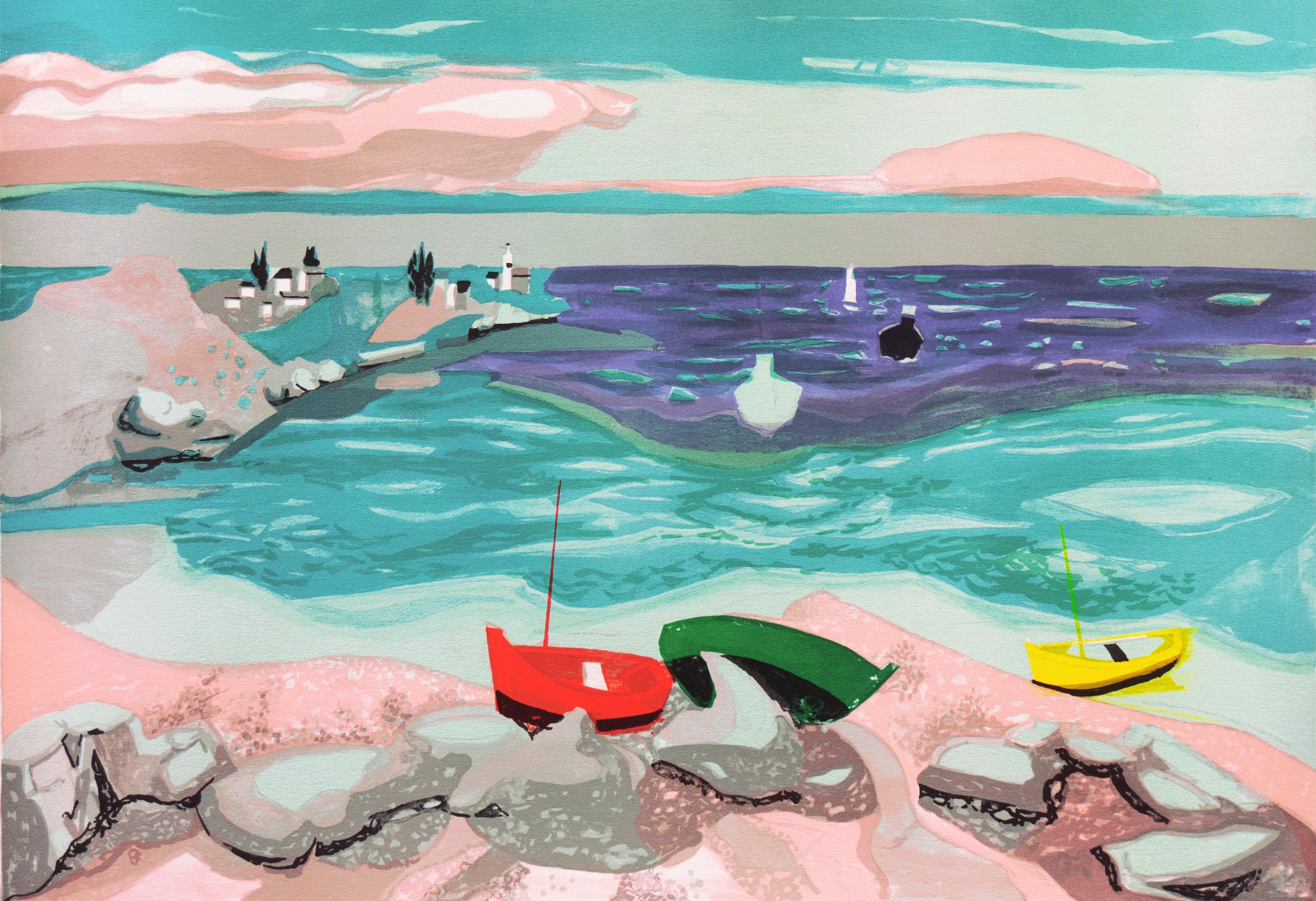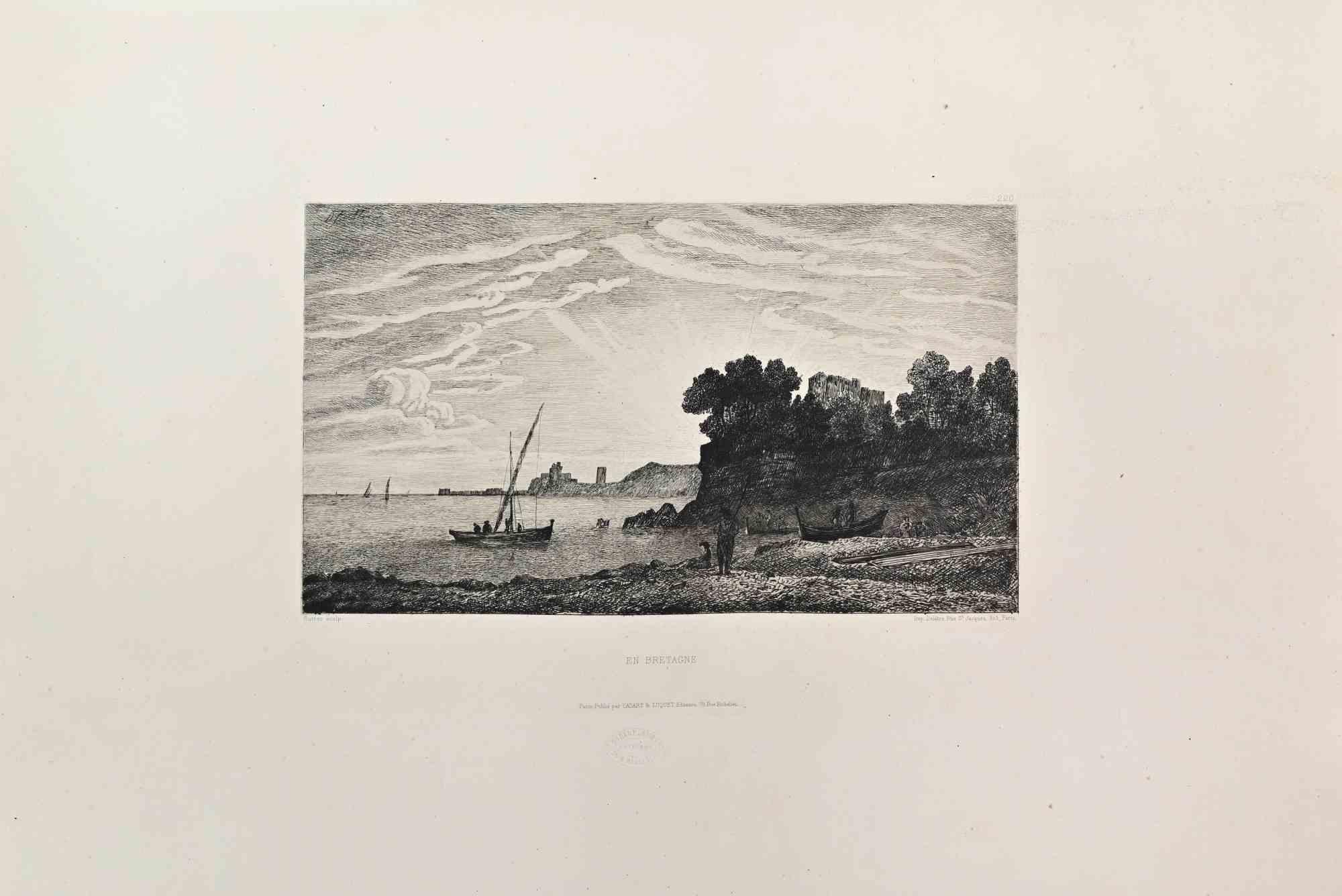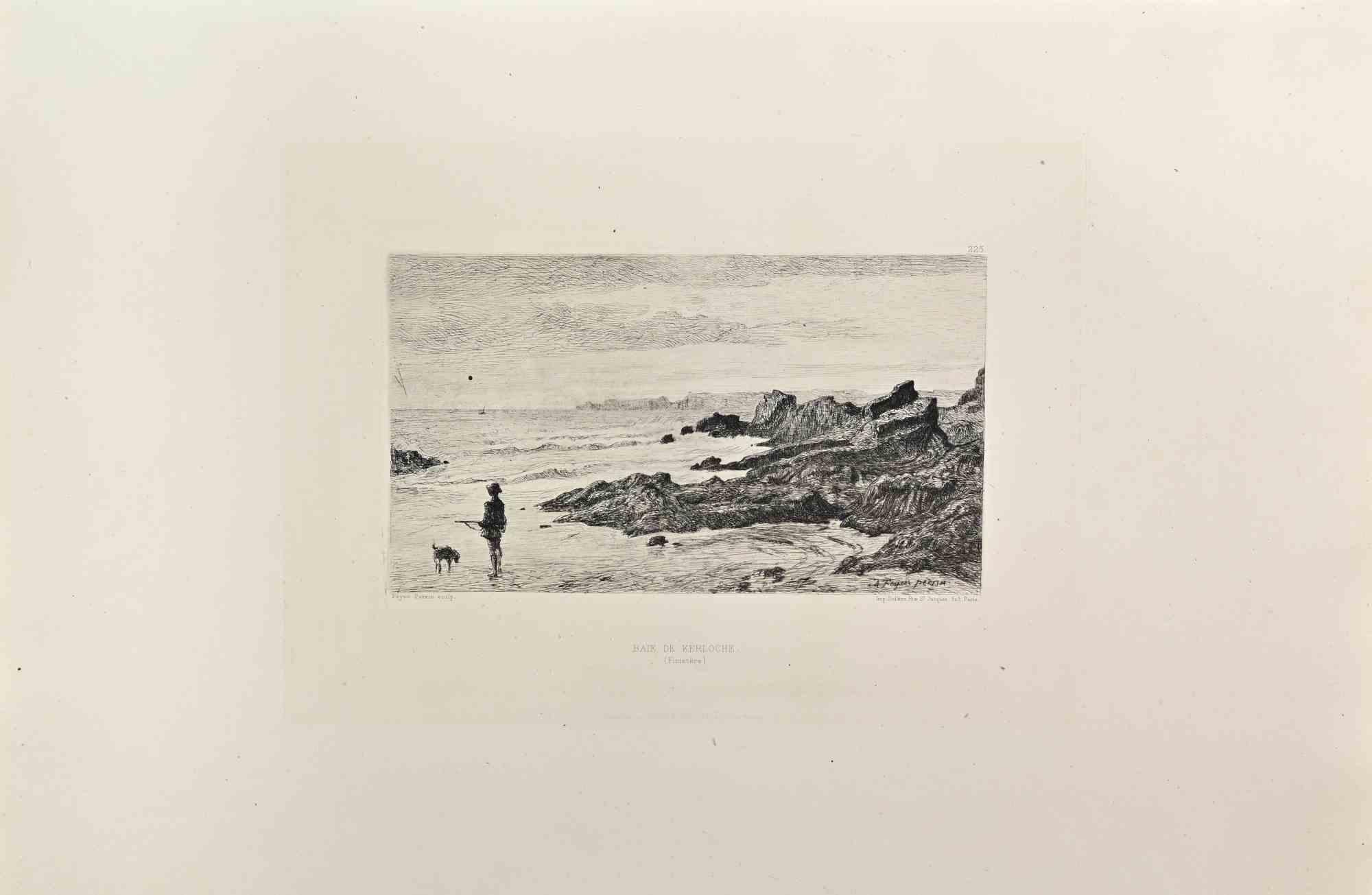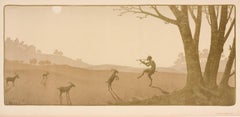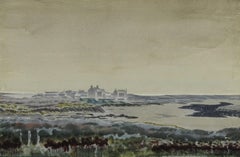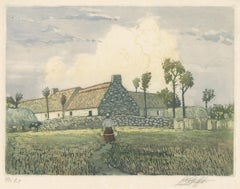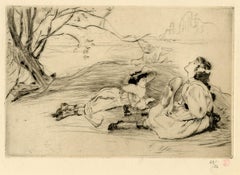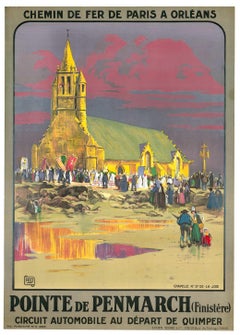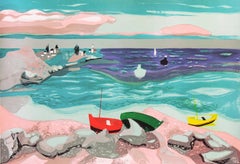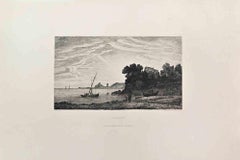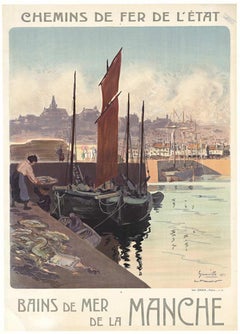Items Similar to La Pointe de Bretteville
Want more images or videos?
Request additional images or videos from the seller
1 of 12
Paul BerthonLa Pointe de Bretteville1899
1899
$350
£272.72
€309.39
CA$503.03
A$553.88
CHF 287.21
MX$6,559.50
NOK 3,645.98
SEK 3,407.58
DKK 2,310.78
About the Item
La Pointe de Bretteville
Color lithograph, 1899
Signed in the stone upper right
Publisher: Sagot, Paris
Edition: Edition: about 200 (per Arwas)
References And Exhibitions:
Arwas 33 2nd state B
Sheet: 13 1/4 X 25 5/8"
Image: 10 3/4 x 23 5/8"
Condition: excellent
Paul Berthon
(b Villefranche, Rhone, 1872; d Paris, 1909)
Little specific is known about the short 37-year life of this French designer and lithographer.
He began his training in Villefranche, where he studied painting. In 1893 he moved to Paris, entering the Ecole Normale d'Enseignement du Dessin. There he became a pupil and disciple of Eugene-Samuel Grasset, the Professor of Decorative Arts, and was also influenced by Luc Olivier Merson. Berthon's main output consisted of posters and decorative panels. However, he also produced bookbindings and furniture designs, both of which he exhibited at the Salon in 1895. He created designs for ceramics for Villeroy & Boch in the late 1890s; and a few designs for the covers of such magazines as L'Image (July 1897) and Poster (May 1899).
His work is in an Art Nouveau style. He adopted that movement's plant and figural motifs, especially the motif of the femme fatale, as well as the long sinuous lines that characterize the movement. These features can be seen in such works as the poster Leçons de violon (1898). Berthon distinguished himself in the production of large, colored posters in the relatively new medium of chromolithography, some of which were printed under the direction of Jules Cheret by Chaix & Company.
The graphic oeuvre of Paul Berthon consists of ninety-four original lithographs. Almost two-thirds of Berthon's original lithographs are what the artist termed, "Panneaux Decoratifs" (Decorative panels). Unlike most Art Nouveau posters, Berthon's panneaux decoratifs included no advertising and no letterpress. They were meant to stand alone as significant works of art in their own right.
A large collection of his work seems to have been destroyed during the world wars. By the start of the First World War the Art Nouveau movement had lost its momentum. The posters of Berthon, Grasset and Mucha were no longer prized possessions, and many of the posters were lost. During the economic depression that followed World War II many of the lithographic posters were used as wallpaper or wrapping paper.
Berthon died in Paris in 1909.
Courtesy: Answers and Enchantedgal
Courtesy of French Wikipedia
Edmond-Honoré Sagot , born in 1857 and died on April 6 , 1917, is a bookseller , art dealer , publisher of prints and original posters . In 1881 he founded the house “Ed. Sagot” in Paris. This establishment still exists under the name “ Sagot - Le Garrec ” and is one of the oldest art galleries still in operation.
Edmond Sagot is the first contemporary art dealer to specialize in prints and posters. Following his example, several print dealers emerged in the early 1890s : Gustave Pellet , Edouard Kleinmann, A. Arnould, then Ambroise Vollard , who served as a driving force in the development, sale and promotion of artists' prints. contemporaries 1 .
Biography
Edmond Sagot opened in Paris in 1881 at 53 rue d'Argout an artistic bookstore which, from 1884, developed its activities towards the trade in prints . The “Ed. Sagot” house then took as its address 39 bis rue de Châteaudun . There are also framing and drawing material.
Sagot sells drawings, etchings , lithographs , then, in 1891, publishes the world's first catalog of posters illustrated by modern and contemporary artists. This event is partly at the origin of what Ernest Maindron and Octave Uzanne soon called “posteromania”. Sagot was one of the pioneers and Parisian leaders of this new art form, his gallery serves as a dissemination relay with the provinces and abroad, and becomes a place of exchange between many art critics and young people. artists 2 .
Later, he associated his son-in-law, Maurice Le Garrec, with his activity, who in 1917 3 took over the gallery under the name “Sagot - Le Garrec, dealer in prints”, and moved to 18 rue Guénégaud . Today the gallery Sagot - Le Garrec, always specialized in printmaking and drawing XIX th and XX th centuries, is located 10 rue de Buci . It is managed by Nicolas Romand, the fifth generation of merchants.
Edmond Sagot is also known for having acquired four coppers belonging to a series of engravings executed by Francisco Goya , the Disparates .
He is the older brother of the Parisian art dealer Clovis Sagot , known as “Sagot le Jeune”.
Publications
Jules Chéret and Paul César Helleu produced posters for Edmond Sagot, but also Alexandre Lunois (in 1894), the young Belgian artist Henri Evenepoel , whose project was exhibited at the Salon pour l'art (in 1896), George Bottini (in 1898), Edgar Chahine (from 1897), or even Georges de Feure .
The gallery edited works by Charles Heyman , Gaston de Latenay , Gustave Leheutre , Alfredo Müller , Manuel Robbe , Tavík František Šimon , Henri de Toulouse-Lautrec , Félix Vallotton .
The gallery published the Paris-Almanach from the end of 1894, containing small lithographs in colors 4 .
La Pointe de Bretteville
The Beach of Bretteville sur Ay is a leisure site to discover during your holidays when staying near Bretteville-sur-Ay (Manche, Normandy). This site is popular among tourists passing through the region.
Located to the south of the Port of Cherbourg along the Atlantic coast in Normandy. bordering the Channel Sea (English Channel).
The name of the locality is attested in the form Bretevilla around 1200 .
Like all the Brettevilles , this Norman toponym is formed from the old French brette which means “Breton”, but in a sense preceding the Middle Ages, that is to say originating in present-day Great Britain . Ville corresponds to the Latin villa , “rural domain”.
- Creator:Paul Berthon (1872-1909, French)
- Creation Year:1899
- Dimensions:Height: 13.25 in (33.66 cm)Width: 25.63 in (65.11 cm)
- Medium:
- Movement & Style:
- Period:
- Condition:
- Gallery Location:Fairlawn, OH
- Reference Number:Seller: FA11638.31stDibs: LU14016519042
About the Seller
5.0
Recognized Seller
These prestigious sellers are industry leaders and represent the highest echelon for item quality and design.
Gold Seller
Premium sellers maintaining a 4.3+ rating and 24-hour response times
Established in 1978
1stDibs seller since 2013
826 sales on 1stDibs
Typical response time: <1 hour
Associations
International Fine Print Dealers Association
- ShippingRetrieving quote...Shipping from: Fairlawn, OH
- Return Policy
More From This Seller
View AllVision Antique
By Paul Berthon
Located in Fairlawn, OH
Vision Antique
Color lithograph, 1899
Signed in the stone upper left (see photo)
Titled in the stone lower right (see photo)
Edition: unsigned edition about 200 (per Arwas)
Published...
Category
1890s Art Nouveau Abstract Prints
Materials
Lithograph
Irish Sea
By Edward Dobrotka
Located in Fairlawn, OH
Irish Sea
Watercolor, 1947
Signed and dated by the artist lower right
Condition: Excellent
Image/Sheet size: 12 x 18 inches
Provenance: Estate of the Artist
...
Category
1940s American Realist Landscape Drawings and Watercolors
Materials
Watercolor
Brittany Landscape with Figure
By Louis Oscar Griffith
Located in Fairlawn, OH
Brittany Landscape with Figure
Etching & color aquatint, c. 1920
Signed lower right (see photo)
Numbered lower left: "No. 21" (see photo)
An early color etching by the artist, based ...
Category
1920s American Impressionist Landscape Prints
Materials
Aquatint
A L'Ombre (In Shadow)
By Louis Legrand
Located in Fairlawn, OH
A L'Ombre (In Shadow)
Etching & drypoint, 1905
Signed with the red stamp of the publisher Pellet (see photo)
Edition: 50 on velin paper, signed and numbered
Publisher: Gustav Pellet, Paris (his red stamp lower right, recto; Lugt 1193)
Condition: Excellent
Image/Plate size: 5-7/8 x 8-5/8" (14.8 x 21.8 cm.)
Sheet size: 11 5/8 x 17 1/8"
Reference: IFF 119
Exteens 229
Arwas 256 v/V
Louis Auguste Mathieu Legrand (29 September 1863 – 1951) was a French artist, known especially for his aquatint engravings, which were sometimes erotic. He was awarded the Légion d'honneur for his work in 1906.
Life
Legrand was born in the city of Dijon in the east of France. He worked as a bank clerk before deciding to study art part-time at Dijon's Ecole des Beaux-Arts. He won the Devosge prize at the school in 1883.[2] In 1884 Legrand studied engraving under the Belgian printmaker Félicien Rops.
Legrand's artworks include etchings, graphic art and paintings. His paintings featured Parisian social life. Many were of prostitutes, dancers and bar scenes, which featured a sense of eroticism. According to the Hope Gallery, "Louis Legrand is simply one of France's finest early twentieth century masters of etching." His black and white etchings especially provide a sense of decadence; they have been compared to those of Henri de Toulouse-Lautrec, though his drawings of the Moulin Rouge, the can-can dance and the young women of Montmartre preceded Toulouse-Lautrec's paintings of similar scenes. He made over three hundred prints of the night life of Paris. They demonstrate "his remarkable powers of observation and are executed with great skill, delicacy, and an ironic sense of humor that pervades them all."
Two of his satirical artworks caused him to be tried for obscenity. The first, "Prostitution" was a symbolic drawing which depicted a naked girl being grasped by a dark monster which had the face of an old woman and claws on its hands; the second, "Naturalism", showed the French novelist Émile Zola minutely studying the thighs of a woman with a magnifying glass. Defended by his friend the lawyer Eugène Rodrigues-Henriques (1853–1928), he was found not guilty in the lower court, but was convicted in the appeal court and then given a short prison sentence for refusing to pay his fine.
Legrand was made famous by his colour illustrations for Gil Blas magazine's coverage of the can-can, with text by Rodrigues (who wrote under the pseudonym Erastene Ramiro). It was a tremendous success, with the exceptional quantity of 60,000 copies of the magazine being printed and instantly sold out in 1891.
In 1892, at the instigation of the publishing house Dentu, Legrand made a set of etchings of his Gil Blas illustrations. The etchings were published in a book, Le Cours de Danse Fin de Siecle (The End of the Century Dance Classes).
Legrand took a holiday in Brittany, which inspired him to engrave a set of fourteen lithographs of simple country life called Au Cap de la Chevre (On Goat Promontory). It was published by Gustave Pellet who became a close friend of Legrand's. Pellet eventually published a total of 300 etchings by Legrand, who was his first artist; he also published Toulouse-Lautrec and Félicien Rops among others.
He did not only work in graphics; he exhibited paintings at the Paris salon of the Société Nationale des Beaux-Arts starting in 1902. In 1906 he was made a chevalier of the Légion d'honneur.
Legrand died in obscurity in 1951. A retrospective exhibition was held at the Félicien Rops museum in Namur, Belgium in 2006 to celebrate his graphic art. The art collector Victor Arwas published a catalogue raisonné for the occasion.
Books illustrated
de Maupassant, Guy: Cinq Contes Parisiens, 1905.
Poe, Edgar Alan: Quinze Histoires d'Edgar Poe...
Category
Early 1900s Art Nouveau Landscape Prints
Materials
Etching
Retour (Homecoming)
By Georges De Feure
Located in Fairlawn, OH
Retour
Color lithograph, 1897
Signed in the stone lower left edge of the image (see photo)
As published in "L'Estampe Moderne"
L'Estampe Moderne appeared each month as a portfolio of...
Category
1890s Art Nouveau Figurative Prints
Materials
Lithograph
Bucolique Moderne
By Auguste Louis Lepère
Located in Fairlawn, OH
Bucolique Moderne
Color woodcut, 1901
Edition of 550 impressions on Holland paper (as here) and an edition of 200 impressions printed on Japan paper signed in pencil by the artist.
References And Exhibitions:
Published in Di Gesellschaft fur vervielfältigende Kunst à Vienne
Reference: Lotz Brissonneau 271 v/V
Illustrated: Musee D'Orsay, Auguste Lepere ou lerenouveau de bois grave, No. 20
Vital, Auguste Lepere 1849-1918, No. 171.
Illustrated:
Musee de le Vendee, no. 171 (see photo)
Musee D'Orsay, Auguste Lepere ou lerenouveau de bois grave, No. 20
Vital, Auguste Lepere 1849-1918, No. 171.
Auguste Louis Lepère...
Category
Early 1900s Impressionist Prints and Multiples
Materials
Woodcut
You May Also Like
Original Pointe de Penmarch vintage French travel poster
By ALO (Charles Jean Hallo)
Located in Spokane, WA
Original 1926 Pointe de Penmarch vintage French travel poster, linen-backed, Grade A- condition, ready to frame.
The poster is in very good condition. The right-hand border has a mark along its outer edge, as shown in the images. The mark is about 1.5" long and .75" wide. It is not a paper loss but a stain. Minimal wear for a used poster...
Category
1920s Art Nouveau Landscape Prints
Materials
Lithograph
$1,480 Sale Price
20% Off
'L'Étretat', French Post-Impressionist, Paris, Academie Chaumiere, Benezit
By Georges Lambert
Located in Santa Cruz, CA
Signed lower right, 'Georges Lambert' (French, 1919-1998) and inscribed lower left, number and limitation, '26/225'.
Georges Lambert first studied in Paris at the Academie de la Gra...
Category
1960s Landscape Prints
Materials
Paper, Lithograph
En Bretagne - Etching by David Sutter - 1860s
Located in Roma, IT
En Bretagne is a black and White etching realized by David Sutter in the 1860s.
Titled in the lower.
Image size: 21x31.
Very good impression with wide margins and a very fresh in...
Category
1860s Modern Figurative Prints
Materials
Etching
Original Bains de Mer de la Manche - Granville vintage Chemin de Fer poster
By Georges Meunier
Located in Spokane, WA
Original Bains de Mer de la Manche vintage poster. Artist Georges Meunier. Archival linen backed in good condition, ready to frame. Printer: Chaix ...
Category
1920s Art Nouveau Landscape Prints
Materials
Lithograph
Baie de Kerloche - Etching by Auguste Feyen Perrin - 1860s
Located in Roma, IT
Baie de Kerloche is a black and White etching realized by Auguste Feyen Perrin in the 1860s.
Titled in the lower.
Image size: 23x32.
Very good impression with wide margins and a ...
Category
1860s Modern Figurative Prints
Materials
Etching
Loguivy le Soir (Loguivy at Evening)
By Henri Riviere
Located in New York, NY
Henri Rivière (French, 1864-1951), Loguivy le Soir (Loguivy at Evening), 1904,Plate 7 for Le Beau Pays de Bretagne. Published by Eugène Verneau, Paris. Color...
Category
Early 1900s Post-Impressionist Landscape Prints
Materials
Lithograph
More Ways To Browse
Antique Holiday
Antique Villeroy Boch
Gary Barsumian
Georges Spiro
Hal Mcintosh
Harold Altman Child
Harold Hitchcock On Sale
Helen West Heller. American. On Sale
Highlands Ski
Hirst Honour
Ivan Rabuzin On Sale
Jacob Lawrence Play 1999
James Sanford Hulme
Jean Paul Loup
Jennifer Dickson
John Collette On Sale
Joseph Feher
Josset Eton College

